Found 4306 matches from 1,400 records in about 0.2437 seconds for phone or e or geodeta.
If there are regular readers of this site out there, you might be interested in the results of the NYC electronics recycling events I blogged about in October.
 Andriana Kontovrakis, Project Manager at the NYC Department of Sanitation writes:
Andriana Kontovrakis, Project Manager at the NYC Department of Sanitation writes:
“We collected 52 tons (104,000 pounds) of obsolete computer materials from more than 1,000 people this past Fall. The material was collected through 8 one-day collection events held between October and December.
We are happy with the turnout and tonnage. This was the first time DSNY held electronics recycling events, so we did not have a pre-set goal. We are assessing how and when we might possibly hold such events in the future, but we do not currently have any events planned.”
Independent of city sponsorship, grassroots groups continue to hold electronics collection events around town.
I just missed yesterday’s Recycle This! and Per Scholas event at Grand Army Plaza in Brooklyn.
On April 17, 2005 from 9 am to 5 pm, the Lower East Side Ecology Center will collect electronics in the North Plaza of Union Square Park.
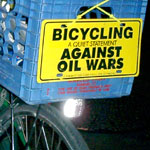 The daughter of a friend was arrested during the Republican National Convention. Her crime: riding her bicycle.
The daughter of a friend was arrested during the Republican National Convention. Her crime: riding her bicycle.
She was one of 5,000 people who rode with Critical Mass that clear August evening, and one of 250 arrested. She spent 25 hours in jail for riding her bike in support ecology, fewer cars, and a more bicycle friendly city.
“She lost a bit of innocence that summer,” says her mom.
Since the RNC, the New York Police Department have continued their campaign of intimidation and harassment, arresting riders and seizing bikes despite a court order. Now the Department is suing Time’s Up!, a nonprofit environmental group, to prevent them from participating in and promoting the rides and to enforce the ban on assembly of 20 or more people in a park without a permit.
The folks at Visual Resistance are facilitating a street art campaign in support of Critical Mass and are calling for designs. They hope to produce materials before the April 29th ride.
They will make the designs available for download and have a few printed. Some suggested themes include supporting/promoting Critical Mass; defending the right to free assembly; and promoting bicycling as a form of transportation.
For more info on Critical Mass and harassment by NYPD, visit the Time’s Up press room.
Poster designs should be 8.5x11 or 11x17 inches, sticker and stencil designs can be any logical size. Find out more.
Mentioned here last year, the Green Map project is an international network of autonomous, collective design projects, promoting local action and environmental resources around the world. They just celebrated their ten year anniversary.
Via email:
March 25, 2005 marks the 10th anniversary of Green Map System, a network of locally-led projects building healthier, more sustainable communities by charting the natural and cultural environment. In a decade, the global Green Map movement has spread to 45 countries, sparking public involvement and encouraging fresh perspectives on familiar landscapes. In nearly 300 diverse cities, towns and rural locales, we’re charting the good life, celebrating community and engaging the future.
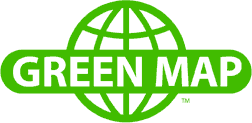 Collectively, Green Mapmakers have published 201 Green Maps — 60 are online and 3 million copies are in use, serving as guides to ecological living. Click GreenMap.org for an update on each map - these are beautiful portraits of place that ignite hope and caring for our beloved hometown environments.
Collectively, Green Mapmakers have published 201 Green Maps — 60 are online and 3 million copies are in use, serving as guides to ecological living. Click GreenMap.org for an update on each map - these are beautiful portraits of place that ignite hope and caring for our beloved hometown environments.
Linking all projects are the Green Map Icons — the world’s only universal symbol set for maps — and a flexible framework for mapmaking. Practical, effective Green Mapmaking tools and resources are being created all the time, based on local experience. Our recent milestones include:
- Green Map Atlas
In 2004 Green Map System produced its first collection of mapmaking stories. Illustrating the origins, methods and local impacts of 10 projects in Asia and North America, the Green Map Atlas is a multimedia anthology — order the book or CD-ROM, or download it at GreenAtlas.org. Written for the public, it was conceived to catalyze action for community sustainability around the world — 100,000 English/Japanese readers have downloaded it already! - Lift-off in Taiwan
Taiwan’s Society of Wilderness has practiced Green Mapmaking since 2000, leading successful workshops across the country. Published in March 2005, their “Energetic Green Map Movement” book features 135 pages of in-depth methodology and colorfully illustrated vignettes on Taiwanese and international Green Maps (including sections of the Green Map Atlas), in Chinese. - Japan’s Networked Accomplishments
Some of the most inclusive Green Map projects are in Japan. Capturing this creative energy and fostering new developments, the GreenMap Japan network has just published a 40 page “Green Map Activity Guide” (English edition expected in August). Their national summer homework challenge in 2004 yielded expressive outcomes, dozens of which can be seen at GreenMap.jp (English Intro). - EXPO 2005 — Nature’s Wisdom
Today, 52 communities in Japan have projects underway. More than 16 of these are creating a citizens’ participation project for Aichi EXPO 2005, under the umbrella of GreenMap Aichi/Chubu Recycle. Opening today, EXPO’s Aichi Prefecture Pavilion features the debut of 30 diverse, local Green Maps. EXPO continues for 6 months, with international Green Maps featured in August. Find out more here. The impacts of this mega event will continue to be charted through 2010 by GreenMap Aichi! - Crossing the Divide
It’s not only in affluent regions that Green Mapmaking is thriving. Indonesia has 8 far-flung projects underway which have published 10 popular maps to date, and Jakarta’s story in the Green Map Atlas has been downloaded 20,000 times. Our 2004 Chinese Initiative has yielded the first 2 mainland projects underway in Beijing and Hangzhou. In the West, Mapa Verde Cuba is thriving as an education and social resource in 12 provinces across the island, plus they are collaborating on the tri-lingual Mapa Verde Americas Community Green Mapping Booklet, due out later this year. From Uruguay to Uganda, Netherlands to New Zealand, Green Mapmakers have honed their communication skills with this community media vehicle. - And at Home
Our New York global headquarters is a catalyst for new projects, a resource and outreach center, archive and connecting point; we also “seed” local youth projects and create new editions of NYC’s original Green Apple Map. Currently, we’re piloting a new mapping concept with our 5th city-wide edition, which will focus on Energy and aim to build the buzz for efficiency and renewables. Beyond the maps, we embrace the challenge of working globally every day with a wonderful, creative alliance dedicated to building sustainable communities. - Our 10th Anniversary Year
Celebrate this important milestone with us! Our 10th anniversary year starts today, so congratulate your local Mapmakers or send your thoughts (and support!) directly to Green Map System. A non-profit 501c3 organization since 2000, Green Map System welcomes your tax-deductible donation online or by mail (PO Box 249, New York, NY USA 10002-0249). Visit our online Store for Green Maps, Atlases, T-shirts and more. With your help, we will develop a new online system that will improve public access to Green Maps and foster collaboration throughout the movement. Your support will also help us build capacity globally and locally, as we prepare to gracefully expand our eco-cultural service for the next 10 years!
Taring Padi in Bahasa Indonesia refers to the sharp tip, or “teeth,” of the rice plant. For the members of the Taring Padi Artists collective it is a metaphor for people power.
Fragments of the old Taring Padi Web site live on in the Internet Archive:
“taring padi is an independent non-profit cultural community which is based on the concept people’s culture. taring padi is committed to using its artistic and cultural pursuits to contribute actively to the democratisation process in indonesia and elsewhere. taring padi will continue to struggle for social justice and liberation from oppression for all peoples, and the environment.”
The collective creates posters and murals, publishes a newsletter, and participates in street performance with puppets, poetry, and musical groups.
From Inside Indonesia:
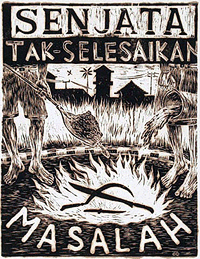 “Yogyakarta [a city in central Java] is renowned historically as a centre for radical cultural protest, particularly in the visual arts. Radical Yogya artists have embraced anti-colonial and revolutionary causes since early in the twentieth century. Like their predecessors, Taring Padi artists promote the concept of people’s art - seni kerakyatan — a loose term that defines the artist’s social commitment and popular orientation. Taring Padi attempt to put this credo into practise through concrete action, rather than just aesthetic empathy for the plight of the ‘oppressed masses.’
“Yogyakarta [a city in central Java] is renowned historically as a centre for radical cultural protest, particularly in the visual arts. Radical Yogya artists have embraced anti-colonial and revolutionary causes since early in the twentieth century. Like their predecessors, Taring Padi artists promote the concept of people’s art - seni kerakyatan — a loose term that defines the artist’s social commitment and popular orientation. Taring Padi attempt to put this credo into practise through concrete action, rather than just aesthetic empathy for the plight of the ‘oppressed masses.’
Mainstream art, the conventional system of curators, galleries and art collectors, is something Taring Padi avoid. Rather, they cultivate relations with other progressive organisations including students, farmers, and the urban poor. Such was the case for the World Food Day action, when Taring Padi collaborated with Mbah Seko and his group of organic farmers called Petani Lestari (Conservation Farmers), as well as with activists from the environmental non-government organisation Keliling. At the demonstration, activists shared out the protest wayangamong themselves. The cast of wayang figures symbolised the various ‘actors’ involved in the pesticide ‘drama’....
In the period before the June 1999 elections, a number of Indonesian cities experienced heightened unrest. Political commentators predicted ‘civil war,’ and the media fuelled the volatile pre-election atmosphere by nurturing perceived religious, ethnic and racial tensions. As a response, Taring Padi began to produce a series of woodcut posters which carried messages promoting solidarity and peaceful social interrelations. Between March and June 1999, they distributed approximately 10,000 woodcut posters throughout major cities in Java, Sumatra and South Sulawesi. The woodcuts, hand-printed on draft paper, were pasted on city streets, on churches and mosques, on village notice boards, in food stalls, in market places.
Among their other artwork, Taring Padi issue a popular pamphlet called The People’s Trumpet. A series of banners and murals resemble the work of Mexican muralist Diego Riviera. Taring Padi banners are often commissioned by other organisations. The women’s division of the National Human Rights Commission ordered a series of them. Titled The evacuation, the banners depict the harsh realities of the refugee crisis in Aceh by focusing on women’s daily struggles.
![]() But Taring Padi also use banners and murals for community purposes, and invite local people to be part of the painting process. Taring Padi’s creative ethos involves a collective, process-oriented production of artwork. They want to eliminate illusive notions of the artist as ‘genius’ or ‘eccentric’ individual, and of the artwork as somehow ‘sacred.’ Taring Padi artwork does not carry recognition of the ‘individual’ artistic creator. It is stamped instead with the Taring Padi ‘kerakyatan’ insignia — a sprig of rice, red star and cogwheel.”
But Taring Padi also use banners and murals for community purposes, and invite local people to be part of the painting process. Taring Padi’s creative ethos involves a collective, process-oriented production of artwork. They want to eliminate illusive notions of the artist as ‘genius’ or ‘eccentric’ individual, and of the artwork as somehow ‘sacred.’ Taring Padi artwork does not carry recognition of the ‘individual’ artistic creator. It is stamped instead with the Taring Padi ‘kerakyatan’ insignia — a sprig of rice, red star and cogwheel.”
See a collection of linocut prints and paintings.
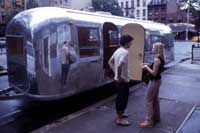 A cousin is in town selling ceramics out of an old jet stream he converted into a nomadic gallery. The Museum of Art and Design (formerly the Crafts Museum) across from the Museum of Modern Art helped arrange a parking space and circulated a press release. This brought New York One, a local cable news channel, to the scene where they filmed a bit in the morning to broadcast a brief story shortly after.
A cousin is in town selling ceramics out of an old jet stream he converted into a nomadic gallery. The Museum of Art and Design (formerly the Crafts Museum) across from the Museum of Modern Art helped arrange a parking space and circulated a press release. This brought New York One, a local cable news channel, to the scene where they filmed a bit in the morning to broadcast a brief story shortly after.
Later that day, passersby gush at the site of the trailer, “Hey! I saw you on the news!”
Their surprise surprises me. If the news supposed to tell us what’s going on, why the surprise when one actually encounters it? Is it just the happy recognition of a celebrity spotting? Or something else? Does the mainstream media, which supposedly shows you the world, also disconnect you from it? Aside from the weather, is the news is always happening somewhere else to someone else?
 One of the few redeeming qualities of winter in New York City are those beautiful columns of steam that rise from the streets. Walking along, you catch these great clouds of vapor churning and billowing — particularly at twilight, through the headlights and street lights.
One of the few redeeming qualities of winter in New York City are those beautiful columns of steam that rise from the streets. Walking along, you catch these great clouds of vapor churning and billowing — particularly at twilight, through the headlights and street lights.
So what’s it all about?
Under the streets of New York City is the largest steam distribution system in the world.
On March 3, 1882, the first steam distribution plant of importance in the U.S. made its first distribution of steam from a central plant at to the United Bank Building on Broadway, sending steam to heat buildings in lower Manhattan.
The New York Steam Corporation, formed July 26, 1880, consolidated with the Steam Heating and Power Company of New York in September 1881. The company was sold in 1915, but when the parent company went bankrupt two years later it was reorganized as the New York Steam Corporation. It was merged into the Consolidated Edison system in the 1930s.
This article from the Gotham Gazette’s infrastructure series draws the broad contours of the current steam system.
Seven steam plants, five in Manhattan and one each in Queens and Brooklyn generate the millions of pounds steam that run under the city’s streets. The steam heats housing, offices, a few churches, and NYC landmarks like the Empire State Building, the Metropolitan Museum of Art, and the United Nations. It is used to press your shirts and in the central sterilization unit St. Vincent’s Hospital. I also note that the system stops south of 96th street.
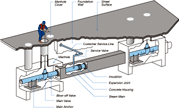 Those plumes in the street may be releasing pressure or perhaps just a leak. The system moves steam at high pressures to maintain the temperature and push it through the system.
Those plumes in the street may be releasing pressure or perhaps just a leak. The system moves steam at high pressures to maintain the temperature and push it through the system.
Three of the plants simultaneously produce both steam and electricity through a process called co-generation. At the height of winter, the system sends out nearly 10 million pounds of steam per hour. Sales from ConEd’s Steam Business Unit account for about 7 percent of total Con Edison revenues.
And because the steam is mass-produced, it is more economical, efficient, and environmentally friendly than the hundred thousand individual oil or gas boilers it replaces. Centralized steam eliminates the need for boilers in individual buildings along with million gallons of heavy fuel oil and traffic from fuel delivery trucks. The steam plants use low sulfur oil or clean-burning natural gas to produce steam. High tech burners further lower nitrogen oxide emissions.
Update 1/9/2010: Here’s a great piece on Urban Omnibus about the NYC steam system.
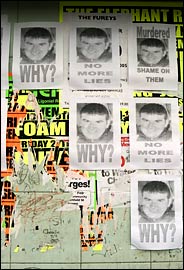 On the topic of posters and terrorism is this piece that ran in the NY Times two days ago about a growing backlash among Catholics to the violence of the Irish Republican Army.
On the topic of posters and terrorism is this piece that ran in the NY Times two days ago about a growing backlash among Catholics to the violence of the Irish Republican Army.
Five sisters are defying intimidation, calling for justice for the murder of their brother and “what is widely seen as a subsequent I.R.A. cover-up.”
As part of the effort, they are posting graphics in the street, both a rallying cry and public defiance of a sector of the community who would silence dissent in the name of the cause.
“Many Catholics in the McCartneys’ neighborhood, a battle-scarred area called the Short Strand, have responded with surprising solidarity.
On the day of the funeral for Mr. McCartney, a popular 33-year-old fork lift operator with two young sons, a thousand people turned up. Graffiti denouncing the I.R.A. popped up on walls, a first in a republican neighborhood; the markings were quickly erased, but quickly reappeared. Small photocopied posters with Mr. McCartney’s photograph appeared on shop windows. ‘No More Lies,’ one said. ‘Shame on Them,’ said another.
Last Sunday, the women held a rally in the neighborhood. Hundreds showed up, including politicians, and several speakers expressed outrage. The sisters held placards that read, ‘Murdered - Who’s Next?’
‘If these men walk free from this, then everyone in Ireland should fear the consequences,’ Paula McCartney, 40, a Queen’s University student, told the crowd, according to news reports. ‘Justice must be done.’”
It is a kind of grassroots resistance to the established resistance, adding further stigma to the violent tactics — from the constituency such tactics are theoretically supposed to benefit.
Still, one has to wonder about the sudden interest of the NY Times in such resistance. The Times is so rarely sympathetic to such activities by left-wing groups. Is it simply the hypocrisy of a righteous group acting less than righteously? Or there another agenda at work? While the I.R.A. may indeed have turned to thuggery (they wouldn’t be the first armed resistance to do so) I suspect a kind of arrogant Statism at play, the sisters provide a convenient proxy to bash those pesky agitators.
Via email:
“Diseño para la solidaridad / Design for solidarity
 From the 8th to the 11th of March, Madrid welcomes an international summit
on ‘Democracy and Terrorism,’ in honor of the first anniversary of 11M. We
would like to take advantage of this international event so that designers
from different countries and cultures contribute their views and personal
opinions regarding this subject. We have created a virtual gallery and would
like to display in different spaces throughout the city with all the works
that we receive.
From the 8th to the 11th of March, Madrid welcomes an international summit
on ‘Democracy and Terrorism,’ in honor of the first anniversary of 11M. We
would like to take advantage of this international event so that designers
from different countries and cultures contribute their views and personal
opinions regarding this subject. We have created a virtual gallery and would
like to display in different spaces throughout the city with all the works
that we receive.
This is a project for the creation and free distribution of graphic material against terrorism and supporting the victims, on the first anniversary of the 11M terrorist attack in Madrid.
MISSION
This project intends to be a public design forum for the creation of images that express points of view on terrorism and promote public debate.
Bad news/ design for solidarity wants to be a symbol for democratic response and citizen participation, on behalf of designers, against terrorism on the first anniversary of the 11M.
The project is conceived as a space that is open to designers all over the world and comes forth parallel to the conference on "Democracy and Terrorism" that will be celebrated in Madrid in February of 2005.
Bad News/ Design for Solidarity hopes to be a symbol for international solidarity against terrorism. For this we need for you to contribute with your creativity and talent.”
When I received the first email about this, I was skeptical. Posters denouncing terrorism because it’s bad? Isn’t that the method of terrorism?
But when I received the second email I took another look. The inclusion of Reza Alavi’s ‘New Iraqis Flag’ and a poster linking war with Wall Street points towards a more interesting analysis of the subject. And promoting public discussion seems like a good way to go.
Submission details and a current gallery of posters are up at http://unmundofeliz.org.
From the Center for the Study of Political Graphics:
“Carlos Cortez was an extraordinary artist, poet, printmaker, photographer, songwriter and lifelong political activist. His mother was a German socialist pacifist, and his father was a Mexican Indian organizer for the Industrial Workers of the World (IWW), also known as the Wobblies. Carlos was a Wobblie until he died. He spent two years in prison for refusing to “shoot at fellow draftees” during World War II.
 After his release, Carlos took a series of jobs: in construction, in a small imported foods shop, in a chemical factory. He also started drawing cartoons in 1948 for the Industrial Worker, the IWW newspaper, but soon learned to do linoleum block prints.
After his release, Carlos took a series of jobs: in construction, in a small imported foods shop, in a chemical factory. He also started drawing cartoons in 1948 for the Industrial Worker, the IWW newspaper, but soon learned to do linoleum block prints.
‘Many radical papers—not having advertising, grants or angels who are rich radicals—operate on the brink of bankruptcy. So Industrial Worker couldn’t afford to make electric plates out of line drawings. I saw that one of the old-timers was doing linoleum blocks and sending them in because the paper was being printed on a flatbed press. I started doing the same thing, and each issue would have one of my linocuts.’
When the price of linoleum became too steep, Carlos started using wood. Used furniture was easy enough to find in any alley. ‘There’s a work of art waiting to be liberated inside every chunk of wood. I’m paying homage to the tree that was chopped down by making this piece of wood communicate something.’ Carlos later became an accomplished oil and acrylic painter, though he always preferred the woodcuts because they were reproducible and affordable.
When the Industrial Worker switched to offset in the 1960s, Carlos began drawing pen-and-ink cartoons. He has also served as editor of the newspaper and on the union’s General Executive Board, and was one of the IWW’s most popular public speakers. In 1985, to commemorate the union’s 80th anniversary, he organized an important exhibition, ‘Wobbly: 80 Years of Rebel Art,’ featuring original works by many IWW cartoonists. Carlos was probably the only IWW artist whose work was exhibited at the Museum of Modern Art in New York. His art is exhibited throughout the United States, Europe and Mexico.
In the 1960s, Carlos married Marianna Drogitis, and in 1965 they moved to Chicago where he became involved with the local Mexican and Chicano mural movement.
‘I’ve always identified myself as a Mexican. I guess this was a result of my early years in grammar school. Even though I resembled my German mother more than my Mexican father, being the only Mexican in a school full of whites made me mighty soon realize who I was. But it was my German mother who started my Mexican consciousness. She said, “Son, don’t let the children at school call you a foreigner. Through your father you are Indian, and that makes you more American than any of them.”’
Inspired above all by the work of José Guadalupe Posada, printmaker of the Mexican Revolution, and the German expressionist Käthe Kollwitz, Carlos blends the techniques and styles of the German expressionists with themes from the ancient Aztecs and modern Chicanos. He made countless images support striking workers, from miners in Bolivia to farm workers in California, though he is best known for large linocut poster-portraits of activists and labor organizers such as Joe Hill, Ricardo Flores Magón, Lucy Parsons and Ben Fletcher.
‘After some 40 years of construction labor, record salesman, bookseller, factory stiff and janitor, I no longer punch a clock for some employer and have entered the most productive phase of my life where I do what I want to do and not what some employer wants me to do for him... As I keep working out ideas, I keep getting more ideas. So I’m going to go out kicking and screaming.’
He passed away last month in Chicago at age 81.
CSPG has posted a couple of images.
See also this interview and remembrance.
 In 1965, Lorraine Schneider, an activist and mother, created the original art for “War is Not Healthy.” She entered the 4" by 4" print into a design contest. Her image was seen as too simplistic and did not win.
In 1965, Lorraine Schneider, an activist and mother, created the original art for “War is Not Healthy.” She entered the 4" by 4" print into a design contest. Her image was seen as too simplistic and did not win.
In an introduction to a book of Schneider’s art work, Barbara Avedon wrote:
“On February 8, 1967, fifteen friends met at our house to discuss ‘doing something’ about the war in Vietnam. We wanted to do something that would communicate our horror and disgust to our elected representatives in one concerted action. We were not ‘bearded sandaled youths,’ ‘wild-eyed radicals’ or dyed in the wool ‘old line freedom fighters’ and we wanted the Congress to know that they were dealing with an awakening and enraged middle class — voters, precinct workers, contributors. We decided to send a Mother’s Day card to Washington. We would print and distribute one thousand — one thousand letters of protest that said in a very ladylike fashion:
For my Mother’s Day gift of this year,
I don’t want candy or flowers.
I want an end to killing.
We who have given life
must be dedicated to preserving it.
Please talk peace.
Lorraine had given our family an etching of ‘Primer’ some months prior to that meeting. Its eloquent, irrefutable, sunflower truth said it all for us. I called Lorraine and asked if we could use ‘Primer’ on the face of the card. She said, yes, and one thousand became two hundred thousand cards. And because of her genius Another Mother for Peace was born.” [source]
Another Mother for Peace was founded to “educate women to take an active role in eliminating war as a means of solving disputes between nations, people and ideologies.”
The overwhelming success of the Mother’s Day card led to the creation of the AMP newsletter, filled with anti-war editorial and reports on the stances of lawmakers on issues related to war and peace. Each newsletter contained a number of action items called ‘Peace Homework’ that encouraged readers to make their voices heard by organizing, educating and communicating with other citizens and their elected representatives.
Thirty-six years later, concerned about the human costs of America’s “war on terror” Joshua Avedon, Barbara Avedon’s son, and Carol Schneider, Lorraine Schneider’s daughter, began to consider — separately — how to revive AMP.
Schneider’s image has become an international icon for the anti-war movement. Supporters of Another Mother for Peace display the image around the world. A simple yet powerful statement of conscience, the sunflower logo helped make Another Mother for Peace a visible anti-war voice.
In cooperation with Another Mother for Peace, the Center for the Study of Political Graphics has reproduced the War is Not Healthy poster, the first edition available since the Viet Nam War. Stickers, pins, and other materials are avaialble from Another Mother for Peace.
page 1 2 3 4 5 6 7 8 9 10 11 12 13 14 15 16 17 18 19 20 21 22 23 24 25 26 27 28 29 30 31 32 33 34 35 36 37 38 39 40 41 42 43 44 45 46 47 48 49 50 51 52 53 54 55 56 57 58 59 60 61 62 63 64 65 66 67 68 69 70 71 72 73 74 75 76 77 78 79 80 81 82 83 84 85 86 87 88 89 90 91 92 93 94 95 96 97 98 99 100 101 102 103 104 105 106 107 108 109 110 111 112 113 114 115 116 117 118 119 120 121 122 123 124 125 126 127 128 129 130 131 132 133 134 135 136 137 138 139 140 141 142 143 144 145 146 147 148 149 150 151 152 153 154 155 156 157 158 159 160 161 162 163 164 165 166 167 168 169 170 171 172 173 174 175 176 177 178 179 180 181 182 183 184 185 186 187 188 189 190 191 192 193 194 195 196 197 198 199 200 201 202 203 204 205 206 207 208 209 210 211 212 213 214 215 216 217 218 219 220 221 222 223 224 225 226 227 228 229 230 231 232 233 234 235 236 237 238 239 240 241 242 243 244 245 246 247 248 249 250 251 252 253 254 255 256 257 258 259 260 261 262 263 264 265 266 267 268 269 270 271 272 273 274 275 276 277 278 279 280 281 282 283 284 285 286 287 288 289 290 291 292 293 294 295 296 297 298 299 300 301 302 303 304 305 306 307 308 309 310 311 312 313 314 315 316 317 318 319 320 321 322 323 324 325 326 327 328 329 330 331 332 333 334 335 336 337 338 339 340 341 342 343 344 345 346 347 348 349 350 351 352 353 354 355 356 357 358 359 360 361 362 363 364 365 366 367 368 369 370 371 372 373 374 375 376 377 378 379 380 381 382 383 384 385 386 387 388 389 390 391 392 393 394 395 396 397 398 399 400 401 402 403 404 405 406 407 408 409 410 411 412 413 414 415 416 417 418 419 420 421 422 423 424 425 426 427 428 429 430 431
[ Back ]
[ Next ]

